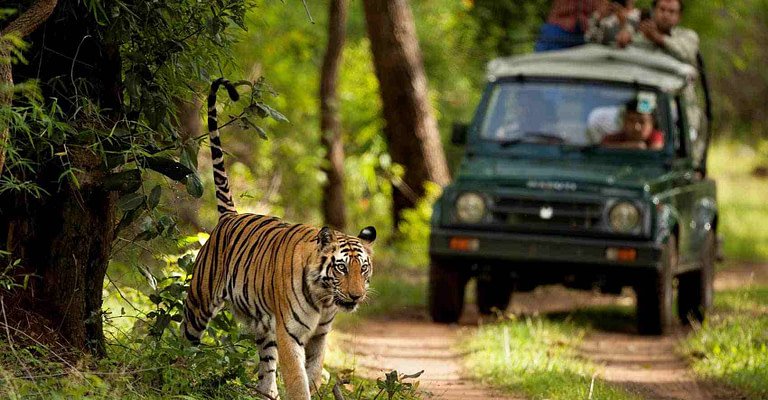Best Time To Visit Jim Corbett National Park

The best an ideal opportunity to visit Jim Corbett National Park is among November and February, i.e., throughout the colder time of year when all the zones are open, and you can spot most of the animals. Another great chance to visit Corbett is during summers which is the best and ideal opportunity to spot animals close to water bodies. The monsoon season, i.e., June-August, is likely not the best time to visit since the national park zones remains off during these months.
Keep In Mind These Dates For Best Time Visit
All zones of Jim Corbett are not open throughout the year.
The Jhirna Zone is open consistently, and you can discover winged animals and incidentally tigers there too.
The Sitabani Zone is likewise open throughout the entire year.
These zones have a drier territory, with rough fields that are effectively traversable in the storm too.
The Dhikala Zone is the most desired of all, where you can locate the maximum number of tigers and their offspring, yet this zone is open just between 15 November and 15 June consistently.
Essentially, the Durga Devi Zone is additionally open just during November and June.
The Bijrani Zone is open from October to June.
Other zones at the park include the Dhela Zone, Garjiya Zone, Pakhro Zone and Sonanadi Zone.
This is on the grounds that the three zones are sloping and have thick timberlands, which are at a higher danger for avalanches. Ways to these zones are likewise not easily accessible in the rainy season.
Remember that the Park closes around evening time, and you can’t camp inside the premises.
The Best Time : The Winters (October – February)
This is the busiest travel season in Jim Corbett National Park, and for a valid justification as well. The monsoon showers leave the park revived and restored, and the entire area gets another rent of life.
Beginning from the center of November, all the zones of the park are open for the travel industry, and you can witness the greatest number of birds and animals during this time. The climate is a flat out joy to be in. With the mercury dropping somewhere in the range of 10°C and 20°C during the day, the atmosphere becomes more pleasing. Around evening time, the temperature goes down to as low as 5°C, so ensure you pack woolens and comfortable garments.
This is also the time when chances of recognizing the greatest number of Royal Bengal tigers are high. They love absorbing the sun in the evenings and are hence, are easy to see. Wildlife photographers are in for a treat, as you can plan to get animals in real life, posing dramatically. Boating, safari rides, nature strolls and traveling are completely available in the colder time of year. So bring along your whole family without any second thoughts for a day of ensured fun!
Not So Good : The Monsoon (June – August)
Jim Corbett National Park lies on a hefty rainstorm belt, which guarantees high precipitation during the southwest storm. While temperatures drop between 25 – 35-degree Celsius, moistness increments radically. The wilderness looks rich, verdant and restored with creepers and climbers spotting the woods floor. The whole air is ethereal and mystical, as you experience nature in its actual wonder. For majority of warm blooded animals, monsoon is the mating season. Hence, you can plan to hear the colorful mating calls of numerous larks and creatures. In the event that you’re here for exploration, Jim Corbett National Park is the best spot to be in the rainstorm. You can travel across the hillocks, however remember that there is a danger of avalanches because of the weighty downpours. Jeep safari is open during this time period in selected zones only.
For families, rainstorms may not be the most
ideal choice to visit this Park as three zones are shut, and you may think that it’s hard to move through the thick vegetation. Also, just the Jhirna and Sitabani Zones are open. Monsoon sees the most number of creepy crawlies in the park too. June to September is the best slow time of year to visit Corbett on the grounds that the costs are low, and resort rates are cut. This makes it ideal for vacationers and solo explorers on a tight spending plan to visit this national park without it being an over the top strain on the wallet.
Good : The Summers (March – May)
The temperature during summers could surpass 40-degree Celsius, but because of the rich greenery in the national park, the site figures out how to stay new and refreshing all through. The dampness is moderately low, appealing a ton of vacationers to visit the spot during summers. This time period is probably the best and ideal opportunity to spot well evolved creatures close to water bodies since each and every zone is open during this season. Different exercises that one may appreciate are stream boating, jeep safaris, nature strolls and calculating which are well known in summer. Since summer sees less vacationers than winters, it’s a phenomenal time for those searching for protection.
Want to know about all the adventures Jim Corbett has to offer? Check out Corbett Park Apart From Safari to find out yourself!
Also, visit the Official Website of Jim Corbett for more news and updates on Jim Corbett.